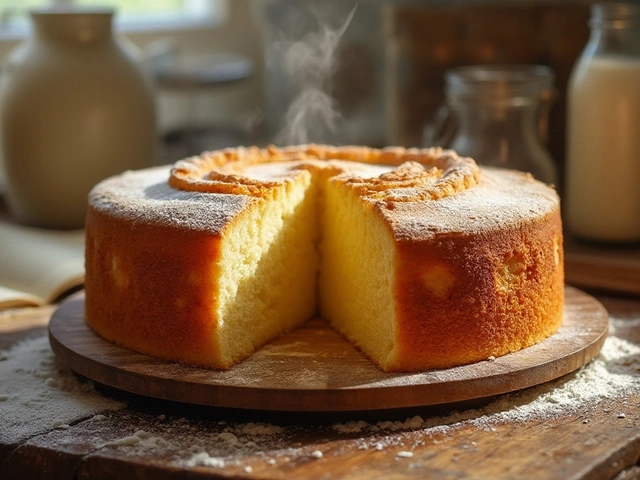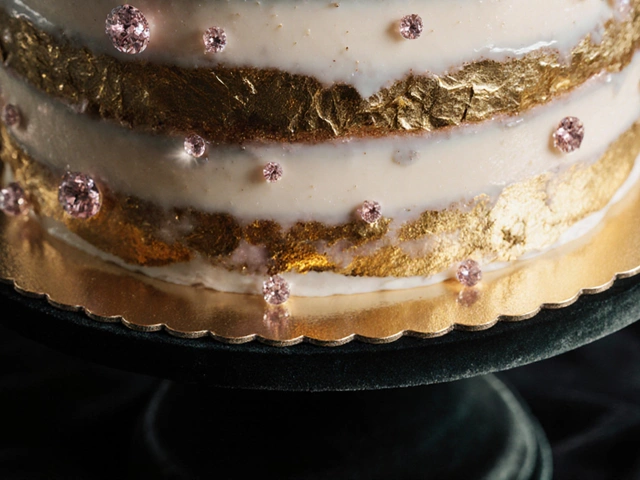Macarons, the charming French confections, are much more than a sweet treat. Their texture captures a harmonious blend of crisp outer shell with a chewy and soft interior. This delicate balance makes them a favorite among both pastry enthusiasts and dessert lovers alike.
Understanding the texture of macarons is key to appreciating—and making—these sweet delicacies. What makes that tiny bit of crunch and melt-in-your-mouth sensation so special? Is it the ingredients, the technique, or perhaps the baking environment?
Dive into the intricate world of macarons as we explore the factors affecting their texture, troubleshoot common issues, and provide essential tips on achieving perfection with every batch.
- Defining Macaron Texture
- Key Factors in Texture
- Common Mistakes and Solutions
- Tips for Perfecting Macaron Texture
Defining Macaron Texture
The macaron texture is nothing short of a masterpiece in the world of pastries. It is a perfect marriage of opposites, with each bite offering an exquisite interplay between crunch and softness, intriguing even to those who consider themselves dessert connoisseurs. The exterior shell, which should be slightly crisp, barely holds back the chewy, almost marshmallow-like interior. This juxtaposition is what sets macarons apart and has elevated them to the status of a gourmet delicacy. But what exactly makes for this ideal texture, and how can one consistently replicate it in their own kitchen?
At its core, the texture of a macaron is influenced by the interaction of just a few key ingredients: almond flour, egg whites, and sugar. The almond flour provides that distinctive nutty flavor while also contributing a delicate, sandy grain that is integral to the structure of the shell. Egg whites, when whipped into meringue, are responsible for the macarons' airy lift. Sugar, in its various forms—granulated and confectioners—adds sweetness and aids in creating that shiny, smooth topside that defines a well-made macaron. A crucial factor here is the 'macaronage' process, where precision in folding the ingredients together determines the batter's consistency, ultimately affecting the texture.
"The texture should be neither too hard nor too moist, but instead a delightful textural contradiction," notes esteemed pastry chef Pierre Hermé, often referred to as the 'Picasso of Pastry'.
Temperature and timing also play a vital role in achieving the right texture. The oven's heat should coax the shells into forming a delicate foot – the ruffled ring at the base of each macaron. Baking them at just the right temperature ensures that the outside hardens properly, locking in moisture within to maintain that chewy center. If you're adventurous enough to try your hand at these delightful treats, it's critical to understand that kitchen humidity, unanticipated oven hot spots, or even the age of your egg whites can transform the expected results. A well-calibrated oven thermometer is an indispensable tool to mastering this mysterious art of macaron making.
The distinct texture of macarons is not just artistry but science as well. As bakers continue to experiment, it becomes evident that even subtle shifts in a recipe or environment can influence the final product. This complexity is exactly what draws both professionals and hobbyists into the whimsical challenge of creating the perfect macaron, each time attempting to reproduce that sublime bite. The allure of macarons is much more than their taste or color. It truly lies in their ephemeral texture, which once perfected, is never forgotten.

Key Factors in Texture
The texture of a macaron is a result of many intricate elements coming together in perfect harmony. One of the primary components influencing this texture is the balance between the egg whites and almond flour. Egg whites, when whipped to stiff peaks, are crucial for giving the macaron its airy structure. Too stiff, and you risk creating a hollow macaron; too soft, and it won’t rise properly. The almond flour must be fine enough to blend smoothly without adding unnecessary weight, yet coarse enough to retain texture. This delicate interaction between the ingredients plays a vital role in the finished macaron's texture.
Environmental conditions also significantly affect macaron texture. Humidity, for instance, can wreak havoc on their delicate shell, causing it to be sticky or soft rather than crispy. Bakers often find that making macarons on a dry day grants the best results. Moreover, the baking process itself is critical—temperature must be consistent to ensure even rising without burning the edges. Timing is everything; leave them too long, and the centers dry out. The notorious macaron feet—a ruffled edge formed during baking—are a texture marker that depends on correct technique and timing.
Another factor is the meringue method used. French, Italian, and Swiss are the three main methods, each offering a distinct impact on the macaron's texture. The French method relies on a simple approach of whipping egg whites and sugar until glossy, often resulting in a more delicate texture. In contrast, the Italian method involves making sugar syrup, which adds stability and creates a denser texture. The Swiss method offers a middle ground, combining gentle heating with whipping for those who seek precision. Each method, while yielding slightly different results, must be executed with care to preserve that signature chewy yet firm macaron bite.
Perfecting the Balance
To secure the ideal macaron texture, attention to detail in preparation is essential. Mixing—often referred to as “macaronage”—must be done until the batter flows like lava. This consistency ensures that the batter spreads but does not flatten too much, maintaining the macaron's distinguished lift during baking. Furthermore, allowing macarons to rest before baking forms a slight skin on their exterior, which aids in developing the characteristic crisp shell.“Baking macarons is an exercise in patience and precision. Each step has its purpose in crafting that sublime textural medley,” says renowned pastry chef Claire Ptak, highlighting the art behind these exquisite confections.
Moreover, pairing and filling macarons properly can impact the eater's perception of their texture. Once baked, macarons should ideally mature for 24 hours in the fridge before serving. This maturing allows the flavors and textures to meld, offering a more cohesive, delightful experience as the fillings infuse their moisture and aroma into the shells.

Common Mistakes and Solutions
Baking macarons is as much an art as it is a science. Even for seasoned bakers, these little delights can be tricky to master. One frequent issue is the 'hollow shell', where the outer shell separates, leaving a gap above the chewy interior. This usually stems from over-mixing the batter. It's crucial to stop folding the mixture just as it starts to fall back into itself like lava. Another reason can be baking at a too high temperature, causing rapid expansion. To avoid this, ensure your oven temperature is accurate with the help of an oven thermometer, as temperature fluctuations can significantly affect the macaron texture.
Another common pitfall is the lack of 'feet', which are the ruffled edges of the macaron shells. If your macarons are footless, it might be due to the insufficient resting time before baking. Allowing the piped macarons to sit until they form a skin on the surface helps prevent cracking and promotes the formation of feet. Also, avoid overly wet batter by ensuring precise measurement of ingredients. An overly runny mixture will spread too much, losing its signature shape and texture.
Cracking and Spreading
Cracking is the bane of many macaron bakers. A perfectly smooth top can turn into a cracked mess if not carefully monitored. Often caused by air bubbles trapped in the batter or an improperly rested shell, these issues can be remedied by a few gentle taps of the baking sheet before resting, which helps air bubbles escape. Additionally, uniform piping technique and consistency in batter thickness play a role in preventing cracks. If cracks do occur, don't be discouraged. Lowering the oven temperature slightly and increasing baking time may help in preventing them in future batches.
The problem of spreading during baking can be maddening, turning what should be neatly stacked macarons into amorphous blobs. Ensuring the batter is not over-mixed is vital, as an over-mixed batter will lack the necessary structure. Proper resting time aids in this as well. Ideally, the shells should feel dry to the touch before they go into the oven. This will also help them maintain their shape as they bake, minimizing spreading.
"Macarons are known for their high level of difficulty, but understanding these small details can significantly improve your baking results. Perseverance and attention to detail lead to the perfect macaron," says Jane Connor, a professional pastry chef and macaron specialist.
Utilizing these solutions can dramatically enhance the results of your next baking session. Remember, practice and patience are key. Each mistake is an opportunity to learn and adapt, eventually leading you to master the intricacies of this exquisite French dessert. Taking the time to carefully observe and refine your technique will not only improve your macaron texture but will also deepen your appreciation for their delicate nature.

Tips for Perfecting Macaron Texture
Creating macarons demands a touch of precision and more than just a dash of patience. Achieving that ideal macaron texture begins with the quality of the ingredients you use. Almond flour serves as the foundation, so ensure it is finely ground and sifted to avoid any undesirable lumps. The egg whites play an equally crucial part, and letting them age for a day or two in the refrigerator allows them to stabilize, leading to stiffer peaks when whipped. This simple step helps in achieving the perfect balance between the shell and the soft interior.
The mixing process, known as macaronage, is arguably the most critical stage. Here, you need to fold the dry ingredients into the meringue carefully, circling the bowl and cutting through the middle with each turn. Proper folding removes just enough air, resulting in a batter that flows like lava—thick but not too stiff. This consistency ensures macarons develop the correct texture once baked, with well-risen feet and a smooth, glossy surface.
Temperature and timing are equally pivotal. Preheating your oven is a must, and investing in an oven thermometer might be a wise decision, addressing any temperature fluctuations. Each oven varies, but typically baking at around 300°F for approximately 15-18 minutes works wonders for most recipes. Keep an eye on macaron edges; they should be firm to the touch yet not brown.
Avoiding Common Pitfalls
Baking macarons can often feel like taming a wild horse; pour in too much humidity, and they collapse, but not enough, and the shells are too hard. The weather can be a silent saboteur. On humid days, a dehumidifier can be your best friend, or you might opt to let your macarons rest a bit longer to form a skin.
"The secret to creating the perfect macaron lies in observing and understanding your oven and ingredients—it’s a dance of science and art," suggests Pierre Herme, the celebrated macaron connoisseur.Each mastery stroke of folding, resting, and baking needs to be in sync to craft that flawless texture.
Cooling your baked macarons also requires care. Let them rest completely before attempting to remove them from the baking sheet to ensure they retain their delicate yet firm structure. Assemble them a day before you intend to serve so they can fully develop flavors, enhancing the delightful experience of biting into a well-balanced French pastry.
Baking tips for macarons aren't static but evolve with practice. Mastering the basics allows you space to inject personal tweaks and creativity. Whether you're a beginner or seasoned baker, remember, each batch teaches you something new about these delightful confectioneries. Documenting your baking sessions, noting down ingredient ratios, resting times, and oven temperatures, will help craft the path to consistent success.





